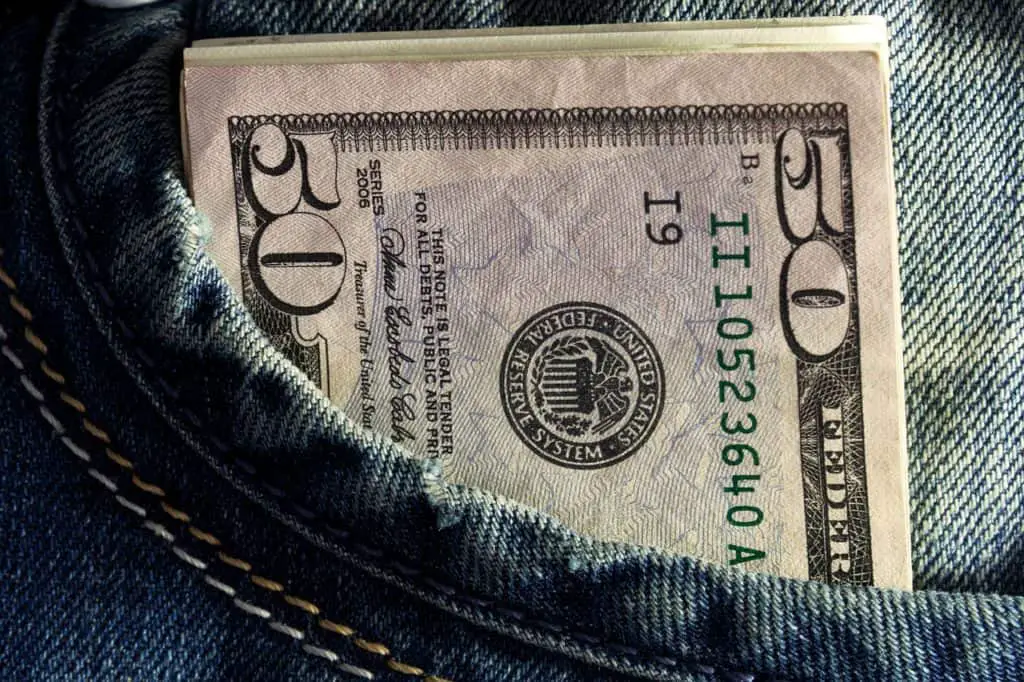“This post may contain affiliate links. Please read my disclosure for more info.
You can save money on a low income by automating your savings to always pay yourself first, and you can do that by adjusting each of your other expenses.
Even on a tight budget, we’ll show how you can reduce spending, eliminate debt and have more money to save. Even minor changes, over time, will have a big effect on your ability to save more money.
So whatever your financial goals are – to save for travel, retirement, start a side business, make a life change, buy a home – we’ll lay out a plan that’ll help you move from paycheck to paycheck to saving money.

Lao Tzu said, “A journey of 1000 miles begins with a single step.” And it couldn’t be more true about saving money.
It doesn’t matter that you don’t have hundreds of dollars to save each month. Like any other improvement in life, it’s not the big flashy wins that move the needle the most. It’s the small, 1% improvements, that over time, make an exponentially bigger difference.
Just by getting started you’re developing the mindset of a saver. The increases will come, but by setting up some simple ways to save, you’re immediately improving the trajectory of your long-term finances.
Table of Contents
Saving money on a lower income is possible by following these steps:
To start saving money on a low income, we’ll outline some basic steps that’ll help in any situation:
- Know where you’re starting from.
- Getting clear on your priorities.
- Devising a strategy.
- Putting yourself in a position to save.
Then we’ll go over some tips that’ll help you to master each one.
To save money faster on a low income, first know where you're starting from

The first step to getting anywhere, financially or otherwise, is to know where you’re starting from. To save more money, you’ll need to know how much is available.
You can create a simple budget using a template. Templates already have categories laid out, so all you need to do is fill in your monthly expenses.
Use one of these free budget templates, or you can even write it out in a notebook.
Don’t worry about adjusting your expenses yet. Just grab your last two or three bank statements and record how much money you spend per month in each area. Total each area, and add up the grand total.
Next up, we’ll do some simple things to improve your financial situation. And soon you’ll be able to spend less money on things that aren’t serving you well, and have more money to save – even on a low income.
Action Step:
Create a monthly budget that tracks all the money you now spend in a typical month. One of these free budget templates can help.
Saving money on a low income is easier when you're protected from emergencies
The next step may not make sense at first, but it’s necessary if you want to position yourself to to save money. Your mission now is to do everything in your power to build an emergency fund of at least $1000 (for now).
Sell things, work overtime, use birthday money, cut back on other things… anything you can do to get $1000 together for emergencies. This might take a few months, but that’s ok.
Not having cash for emergencies, and paying high interest rates on never-ending credit card payments is a big reason why almost 80% of us never move past paycheck to paycheck life.
There will always be unexpected expenses, and if you don’t have a way to pay cash, you’ll always be behind the eight ball – and never have enough money to save.
Next up is an essential part of setting up your emergency fund.
Related topics that could help to build your fund:
Use separate bank accounts for emergency funds and monthly expenses
The key to an emergency fund – other than regular deposits – is that it needs to be separate from your checking account. Mingling emergency money with bill paying money doesn’t work.
When emergency money is in your checking account, it’s tempting to spend. You’re also playing a guessing game about how much money is really available.
And if you’re building a nest egg for emergencies, why not earn interest from it?
The best savings account we’ve come across is the CIT Savings Builder account. They pay interest rates about 11 times higher than the average bank or credit union because they’re an online bank.
Your local bank may have friendly tellers, but the only interaction you’ll ever have with this account is when you need to make a withdrawal. CIT offers free transfers, and your deposits can be automated.
Action Step:
Open a dedicated savings account for your emergency fund. It’s not important if you can’t deposit hundreds of dollars a month into it yet – that’ll come. The big step here, is to just get it opened.
Paying off high-interest debt will shift you into high gear
Debt is an easy trap to fall into, especially if your income is low. When credit cards are your only option in an emergency, the high-interest debt payments can trap you in paycheck to paycheck mode for decades.
So when you’ve got at least $1000 in an emergency fund, a great next step is to focus on eliminating credit card debt. Your emergency fund will help you to break the debt cycle.
Saving money is our ultimate goal, but eliminating high-interest debt first is a great way to create the opportunity to save.
In How to Get Out of Debt – and Stay That Way you’ll find two great debt reduction methods, the debt snowball, and the debt avalanche.
Putting away credit cards is one of the best ways to save more money
So far, we’ve documented how much we’re spending each month, and setup an emergency fund to stop adding to your debt during emergencies.
But if you’re using credit cards for non-emergencies too, that’s a big obstacle in your ability to save.
Our society promotes get it now, pay later, but normalizing high-interest debt month after month, year after year, makes it impossible to save.
Monthly payments on credit card debt curbs your lifestyle, and also causes you to forgo thousands of dollars in interest from the deposits you could be making. You’re essentially putting your life on hold.
The next step is to put your credit cards away and vow to stop using them. At least until you adjust your budget and create a systematic savings routine.
Action Step:
Put away your credit cards and vow not to use them until your budget includes a systematic savings program.
Creating money to save - even with a tight budget
So far we’ve laid the groundwork:
- We’ve documented income and expenses.
- We’ve created an account to capture savings.
- We’re eliminating high-interest credit card debt to boost your ability to save.
Now we’ll go further and find extra money to save. If you’re creating a brand new budget, it’s pretty common to find lots of small changes that together, will reduce your monthly expenses significantly.
Getting your monthly expenses documented is a good first step. But reducing your monthly payments is sometimes easier said than done.
What do you eliminate?
What do you cut back on?
When you’re accustomed to your lifestyle it’s tough to know where to start unless you have a plan. Knowing what your personal priorities are for the next year or two is a great way to begin.
When you become clear about your personal core values, then define just a couple goals for yourself, spending decisions suddenly become easier.
Action Step:
Define one or two personal goals for the next year. To help you sort out your core values, check out:
10 ways to reduce monthly expenses and have more money to save:
1. A great way to spend less money on TV

If you still subscribe to cable, check your bill to see how much money you pay to rent cable boxes, remotes and for inflated bundled pricing.
Switching your TV service provider is a great way to recover extra money in your budget. Here are 20 Cable TV Alternatives that’ll reduce monthly expenses immediately.
2. Getting the best deal on insurance means more money for your savings account
If you’ve been with your auto or home insurance carrier for awhile, you’re probably not getting the best deal.
Go to a neutral site like Policy Genius for a free quote. They don’t need your phone number. Just grab your current policy, enter the coverage you have now, and they’ll send several free quotes within 24 hours.
We spent a total of about an hour, and were able to get policies with lower rates for car insurance and home insurance for $1000 less per year.
3. There are cell phone plans to fit a tight budget
This falls under the heading of, question everything.
Granted, we all use cell phones, but really – what’s the bottom line? We need a device that’ll call, text, take decent photos, notes, browse the web…
If you’re with one of the major carriers now, you’ll save around $100 a month with a cell phone plan from a carrier like Republic Wireless.
Republic doesn’t support iPhones, but they do feature all the latest androids like Samsung, Motorola and others.
Imagine paying $25 per month for unlimited talk and text with 2 gigs of data. And only $5 a month for each additional gig.
Like I said, question everything.
4. Downsizing your living space can relieve a tight budget

A roof over our head is a necessity, but the square footage of our home isn’t what we’ll be most proud of later in life. It’s the stuff we did, built, improved, or the people around us that’ll mean the most.
So if your goal for the next few years is to launch a business, eliminate debt, or ramp up your savings, but 40% or more of your budget goes to housing costs, it could be worth downsizing.
It’s a tough choice to make, but sometimes taking a temporary step back makes it possible to make permanent steps forward.
5. Lower your monthly payments by refinancing
Do you have a home loan that’s more than a few years old? You may be able to refinance to a lower rate and have more money at the end of the month to save or invest.
We recently did this and lowered our monthly payment by $400 per month.
6. Create extra money in your budget by eliminating car payments

Self-made millionaire and author David Bach says, “buying a new car is the single worst financial decision you can make.”
A new car is one of the fastest depreciating items you can buy, and to top it off, most cars sit unused 95% of the time.
The average car payment is around $450-$475 per month. If you suddenly had that to work with, you’d see your net worth rise each month.
Here’s an alternative from Dave Ramsey that’ll enable you to save money much faster than tying it up on a car payment for 5 years:
- Save about $2000 and pay cash for a car. Don’t worry, this part is temporary.
- Instead of paying that $450 a month to a car loan, deposit it into a savings account for 10 months. We’ve used CIT Bank’s Savings Builder account, because it pays about 11x the interest rate of local banks.
- Now, sell your $2000 car and combine the proceeds with your $4500 to get something decent in the $6000 range.
- Now you have a car that’ll last awhile, with no car payment.
And if you keep saving that $450-$475 each month, you’ll set yourself up with a nice emergency fund, a car fund, pay off debt, and then start accumulating savings.
7. The best way to spend less money on shopping is to remove the temptation

It’s impossible to buy something these days without someone asking for your email address. Have you ever counted how many emails a typical store sends you in a month?
I just searched my email for “J Crew” and believe it or not, there’s an email every single day for the past month!
Even if you’re buying things at a “discount”, it’s hard not to be tempted to buy more items per year than you would have otherwise.
Just unsubscribe.
8. Give Yourself an allowance - in cash

Sure, we’re trying to save money on a low budget, but let’s face it. We all spend a few bucks every week. When you use a debit card for $5 here, $9 there, it’s easy to lose track of how much is slipping through your fingers each month.
When you have to fork over cash, there’s more of an emotional involvement. You know exactly what you have left, and you’ll be more inclined to think of alternatives.
Since bills are fairly predictable, they can be paid and tracked electronically. But giving yourself an allowance in cash motivates you to spend it more carefully.
9. A meal plan can significantly reduce monthly expenses at the grocery store

When you total your monthly expenses, take note of how much money you spend on all food. Not just groceries, but also take-out, sit-down restaurants, work lunches and convenience stores.
You’ll probably find that other than your rent or mortgage, food is your next highest monthly expense. But the good thing is, there’s a lot of flexibility in food costs.
An easy way to spend less money on food is to meal plan. When you come home from the grocery store with exactly what you need for meals and snacks, it’s pretty common to save several hundred dollars each month.
Meal plans don’t need to be elaborate. We spend about fifteen minutes per week and were able to reduce food costs by $300.00 each month. Most of that is by reducing the need to buy food at other places, and by reducing extra trips to the grocery store.
We use $5 Meal Plan which sends us complete meal recipes, along with a combined shopping list for the meals we select. The meals average about 20 minutes to make, and cost only about $2 per person. Spending $5 each month to lower our monthly bills by $300 is a great trade-off!
Action Step:
Total your monthly expenses on food for a typical month. Then plan your meals for two weeks and compare the total cost with a plan, to your food costs without a plan. The difference is likely to be a few hundred dollars.
10. Making extra money is a great way to reduce high-interest debt quickly

If one of the reasons you’re struggling to save more money is because you’re saddled with debt, you’ll want to take action to reduce it quickly.
Making minimum payments can drag on for years, and the opportunity cost in lost interest on savings can be enormous.
Making extra money is one of the quickest ways to improve your financial situation. But you don’t want to jump at the first part-time job that comes along.
Yes, it’s additional money coming in, but working 20 hours at the dollar store for minimum wage is just low pay in exchange for spending time away from home.
A great way to bring in extra income is with a side hustle that you can start in your spare time. Let go of the mindset that you don’t have experience. There are dozens of side gigs you can start cheaply and grow gradually as you become more experienced.
Action Step:
Once you’ve examined your budget and adjusted as many expenses as possible, consider bringing in additional money with a side hustle. Here are 20 Proven Ways to Make $100 a Day.
Saving money on a low income is possible when you take control

It’s easy to say, “just create a budget” or “just cut back on unnecessary expences“.
Ok, but how?
Here are two thought processes to keep in mind as you prioritize your monthly expenses:
1. Know how to prioritize monthly expenses for your life
We can’t afford everything, but you should be able to afford some things. The first step in budgeting is to figure out what’s most important in your life right now and in the future.
When you define your personal core values, it becomes clear where you should spend more, less, or decide to eliminate.
Here’s how you can begin aligning your monthly spending with your personal values:
Values Based Budget: How to Save Money and Do Things You Love.
2. Make periodic adjustments
We don’t often hear Darwin’s theory applied to money, but it kinda makes sense:
“It is not the strongest or most intelligent who will survive, but those who can best manage change.”
I guess if you change survive to thrive it makes a lot of sense!
Change is eternal, whether it’s in your personal life, or a product or service you currently buy. So we need to roll with the punches and adjust our spending.
Something that made sense a year ago, might not now. Whether it’s your cable bill, your commute, or even how you spend your spare time, be open to change.
Use automation to your advantage

According to one Neilson study, one in three families making from $50,000 to $100,000 are living paycheck to paycheck. And so are one in four families making $150,000 or more!
So saving money and growing wealth isn’t a matter of making six figures.
It’s more about managing your money. Making small changes to funnel your paycheck where you want it to go before it slips through your fingers.
Like Warren Buffet said, “Don’t save what is left after spending. Spend what is left after saving.”
The best way to do that is to automate as much as you can. By setting up automatic transfers from your checking account on payday, you won’t need to make dozens of spending decisions at the end of the month.
Controlling your money is one of the best ways to control your life
One thing we all have in common is the desire to control our own destiny. To have choice in our life. Getting control of your financial situation is one of the best ways to do that.
Regardless of your income level, you can put yourself in a position to save. And it doesn’t need to happen overnight.
Small changes, done consistently over time, will change your trajectory from struggling to growing wealth:
- Taking control by documenting your monthly expenses in a budget.
- Having dedicated emergency savings to end your reliance on credit cards..
- After saving $1000, crushing credit card debt and putting your credit cards away.
- Question every monthly expense. If you’re not sure how to prioritize your spending, check out Values Based Budgeting – Save Money and Do Things You Love.
- Examine your food costs and consider a meal plan – a great way to save a lot of money fast.
- After you’ve adjusted your spending, consider a side gig. Generating extra income is one of the best ways to reduce debt quickly and put yourself in a better position to save.
How about you?
Have you been in a jam, and been forced to come up with any unique ways to save money that worked well?



